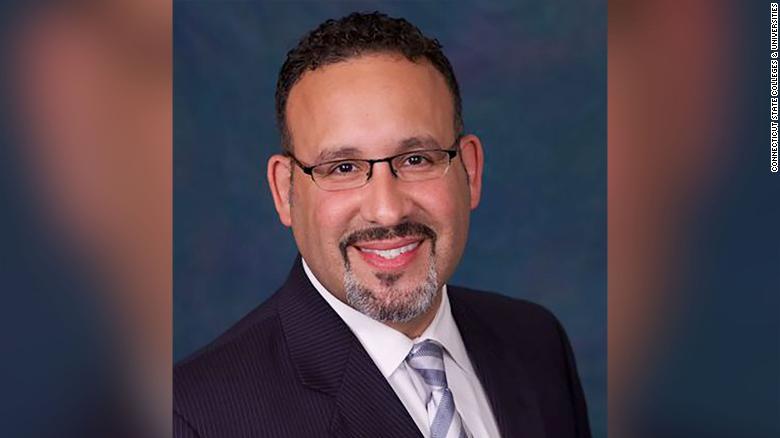Secretary of Education Nominee Miguel Cardona Expected to Support Dual Language Schools
In Miguel Cardona, President Biden’s nominee for education secretary, bilingual education advocates see an ally who can help them overcome remote learning challenges

After becoming Connecticut education commissioner in 2019, one of the first schools Dr. Miguel Cardona visited with Connecticut Governor Ned Lamont was the Silvermine Dual Language Magnet School in Norwalk.
During the tour, Cardona told the school’s principal, Elizabeth Chahine, that if he could do anything else but what he was doing, he would teach at a dual language school.
“We talked about staffing and particularly attracting teachers of color,” Chahine says. “We talked about how dual language education provides opportunities not just for our students but also to bring more diversity into the district.”
Cardona’s passion for these subjects are inspired by personal experience. He was born in public housing to parents who only spoke Spanish at home. When he started school, he struggled to learn English.
“I had to learn how to code-switch early. At first it was with language, but it soon became necessary for other nuances of the cultures in which I was immersed,” Cardona wrote in an article attempting to encourage other teachers of color to join the profession.
Cardona got a masters in bilingual education before receiving his doctorate in education. During his 2019 confirmation hearing for Connecticut’s education commissioner he said, “Our success as a state will be dependent upon how we support students who are learning English as a second language.”
Now as President Joe Biden’s nominee for Education Secretary, Cardona is expected to be a highly visible proponent of dual language schools.
Tools and ideas to transform education. Sign up below.
“I’m very excited by this new secretary of ed,” says David Rogers, executive director of Dual Language Education of New Mexico, which supports dual language programs in New Mexico and beyond.
According to the U.S. Department of Education, one in 11 U.S. K-12 students is an English language learner, or ELL. Supporting these students is vital to closing achievement gaps and creating educational equity, say dual language advocates.
Research shows that high-quality, long-term dual language programs can close the achievement gap in literacy between English learners and native speakers in five to six years.
“Typically, dual language programs first and foremost are meant to service English language learners,” Chahine says. “The wonderful thing about dual language education is in the end, all students benefit. In fact, if you look at long range research that's come out of other states such as North Carolina, it shows that dual language students outperform their monolingual peers.”
But ELLs are not the only ones who benefit. Research also shows that this model provides a significant education benefit to both English learners and native speakers.
“We know there’s cognitive strength in a bilingual brain,” Rogers says.
Challenges to Expanding Dual Language Schools
The U.S. is home to more than 2,000 dual language schools. But even with the anticipated support of the new education secretary nominee, there are obstacles to launching new programs.
“The biggest challenge is staffing and finding individuals with the right certifications,” says Dr. Alexandra Estrella, superintendent of Norwalk Public Schools in Connecticut.
Previously, as superintendent of New York City’s District 4 in East Harlem, Estrella oversaw the opening of eight dual language programs. Finding bilingual qualified teachers is particularly difficult for higher grades as subject matter becomes more specialized, she says.
Another concern is that the popularity of these programs in white, affluent districts will lead to the schools being less focused on the needs of ELLs. The University of Connecticut, Cardona’s alma mater, has recently been awarded a $179,000 grant from the U.S. Department of Education’s Office of Postsecondary Education to address these concerns by promoting a greater focus on sociocultural competence.
The pandemic has also been challenging for dual language educators and learners.
“When we think about language learning, so much language happens through body language,” Chahine says. Many of these nonverbal cues are lost during video class sessions. Also, the important time between classes is eliminated in remote settings. “For our multilingual learners, so much of their learning happens out on the playground or at recess,” Chahine says.
Advice for Districts Interested in Dual Language Education
Rogers says that educators interested in bringing dual language to their districts should remember to not rush the process.
“It’s a huge undertaking,” Rogers says. Because of the popularity of the approach in recent years, some schools have jumped into launching a program for first-grade learners without the proper resources to continue beyond that. “They get into issues because they can’t find the teacher who is going to take over for second grade,” he says.
Before launching a program, Rogers advises reaching out to a dual language school that serves a similar population as your school and observing what they are doing.
Digital resources are also available, including Guiding Principles for Dual Language Education, which can be downloaded for free. Dual Language Education of New Mexico annually hosts the largest dual language education conference, La Cosecha Dual Language Conference.
Estrella says that it is important remember that the value of a dual language education goes beyond test scores.
“We have to keep in mind that we need to value each child: who they are, where they come from, and what they bring,” she says. “Most students in dual language programs outperform their peers, but most importantly they feel that they’re part of a community.”
Further Reading
Erik Ofgang is a Tech & Learning contributor. A journalist, author and educator, his work has appeared in The New York Times, the Washington Post, the Smithsonian, The Atlantic, and Associated Press. He currently teaches at Western Connecticut State University’s MFA program. While a staff writer at Connecticut Magazine he won a Society of Professional Journalism Award for his education reporting. He is interested in how humans learn and how technology can make that more effective.

